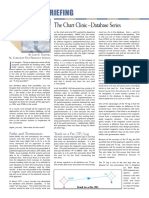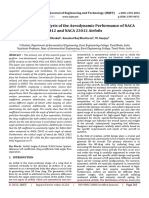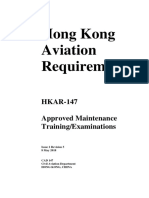Location Numbering Systems - Aircraft Structures - Aircraft Systems
Location Numbering Systems - Aircraft Structures - Aircraft Systems
Uploaded by
Trần Triệu PhongCopyright:
Available Formats
Location Numbering Systems - Aircraft Structures - Aircraft Systems
Location Numbering Systems - Aircraft Structures - Aircraft Systems
Uploaded by
Trần Triệu PhongOriginal Description:
Original Title
Copyright
Available Formats
Share this document
Did you find this document useful?
Is this content inappropriate?
Copyright:
Available Formats
Location Numbering Systems - Aircraft Structures - Aircraft Systems
Location Numbering Systems - Aircraft Structures - Aircraft Systems
Uploaded by
Trần Triệu PhongCopyright:
Available Formats
Figure 4.
Wing stations are often referenced off the butt line, which bisects the center of the fuselage longitudinally. Horizontal
stabilizer stations referenced to the butt line and engine nacelle stations are also shown
Another method is used to facilitate the location of aircraft components on air transport aircraft. This
involves dividing the aircraft into zones. These large areas or major zones are further divided into
sequentially numbered zones and subzones. The digits of the zone number are reserved and indexed
to indicate the location and type of system of which the component is a part. Figure 5 illustrates these
zones and subzones on a transport category aircraft.
Figure 5. Large aircraft are divided into zones and subzones for identifying the location of various components
RELATED POSTS
Primary Flight Control Surfaces and Dual Purpose Flight Control surfaces
Secondary or Auxiliary Control Surfaces
Other Wing Features
Access and Inspection Panels
Helicopter Structures
YOU MAY ALSO LIKE
Home Airframe Sitemap Powerplant Sitemap AMT General Sitemap Handbooks Aviation Glossary
SPONSORED SEARCHES
aircraft systems boeing aircraft aircraft components
aircraft structures aircraft fuselage aircraft airframe
Search This Site
Location Numbering Systems - Aircraft Structures
Even on small, light aircraft, a method of precisely locating each structural component is required.
Various numbering systems are used to facilitate the location of specific wing frames, fuselage
bulkheads, or any other structural members on an aircraft. Most manufacturers use some system of
station marking. For example, the nose of the aircraft may be designated “zero station,” and all other
stations are located at measured distances in inches behind the zero station. Thus, when a blueprint
reads “fuselage frame station 137,” that particular frame station can be located 137 inches behind the
nose of the aircraft.
To locate structures to the right or left of the center line of an aircraft, a similar method is employed.
Many manufacturers consider the center line of the aircraft to be a zero station from which
measurements can be taken to the right or left to locate an airframe member. This is often used on the
horizontal stabilizer and wings.
Unmatched technology OPEN
Recent Posts
GAS WELDING PROCEDURES AND
1
TECHNIQUES - AIRCRAFT
WELDING
The applicable manufacturer’s numbering system and abbreviated designations or symbols should The material to be welded, the
thickness of the metal, the type of
always be reviewed before attempting to locate a structural member. They are not always the same. joint, and...
The following list includes location designations typical of those used by many manufacturers. Read more
Fuselage stations (Fus. Sta. or FS) are numbered in inches from a reference or zero point CHARTS AND GRAPHS - AIRCRAFT
2
known as the reference datum. [Figure 1] The reference datum is an imaginary vertical DRAWINGS
Graphs and charts are pictorial
plane at or near the nose of the aircraft from which all fore and aft distances are measured. representations of data. They enable
The distance to a given point is measured in inches parallel to a center line extending you to...
Read more
through the aircraft from the nose through the center of the tail cone. Some manufacturers
may call the fuselage station a body station, abbreviated BS. TURBOPROP, TURBOFAN ENGINES
3
AND STARTING PROCEDURES -
GROUND MOVEMENT OF
AIRCRAFT
Turboprop EnginesThe starting of any
turbine engine consists of three
steps...
Read more
AIRCRAFT SPECIAL INSPECTIONS
4
During the service life of an aircraft,
occasions may arise when something
out...
Figure 1. The various body stations relative to a single point of origin illustrated in inches or some other measurement (if of
Read more
foreign development)
MANUFACTURING AND IN-
Buttock line or butt line (BL) is a vertical reference plane down the center of the aircraft from 5
SERVICE DAMAGE - ADVANCED
which measurements left or right can be made. [Figure 2] COMPOSITE MATERIALS
Manufacturing DefectsManufacturing
defects include:DelaminationResin
starved...
Read more
Figure 2. Butt line diagram of a horizontal stabilizer
Water line (WL) is the measurement of height in inches perpendicular from a horizontal
plane usually located at the ground, cabin floor, or some other easily referenced location.
[Figure 3]
Figure 3. Water line diagram
Aileron station (AS) is measured outboard from, and parallel to, the inboard edge of the
aileron, perpendicular to the rear beam of the wing.
Flap station (KS) is measured perpendicular to the rear beam of the wing and parallel to,
and outboard from, the inboard edge of the flap.
Nacelle station (NC or Nac. Sta.) is measured either forward of or behind the front spar of
the wing and perpendicular to a designated water line.
Open 24/7 to keep you ying.
Online marketplace for new
& used aerospace products
In addition to the location stations listed above, other measurements are used, especially on large
aircraft. Thus, there may be horizontal stabilizer stations (HSS), vertical stabilizer stations (VSS) or
powerplant stations (PPS). [Figure 4] In every case, the manufacturer’s terminology and station
location system should be consulted before locating a point on a particular aircraft.
You might also like
- Melissa Malde - What Every Singer Needs To Know About The Body-Plural Publishing, Incorporated (2020)Document333 pagesMelissa Malde - What Every Singer Needs To Know About The Body-Plural Publishing, Incorporated (2020)Mary KellyNo ratings yet
- 737 Performance Reference Handbook - EASA EditionFrom Everand737 Performance Reference Handbook - EASA EditionRating: 4.5 out of 5 stars4.5/5 (3)
- Introduction to Fly-By-Wire Flight Control SystemsFrom EverandIntroduction to Fly-By-Wire Flight Control SystemsRating: 5 out of 5 stars5/5 (1)
- Introduction To Jeppesen Charts (STD) 15-DEC-22Document282 pagesIntroduction To Jeppesen Charts (STD) 15-DEC-22patcharaphol charoenchonNo ratings yet
- How To Read Jeppesen Departure Chart?Document66 pagesHow To Read Jeppesen Departure Chart?chhetribharat08100% (3)
- Understanding Approach PlatesDocument16 pagesUnderstanding Approach PlatesAli Basmaci100% (2)
- BodyStation AlltoRefiMaldini 161229004Document5 pagesBodyStation AlltoRefiMaldini 161229004allto reffNo ratings yet
- Aircraft Engine Performance Study Using Flight Data Recorder ArchivesDocument12 pagesAircraft Engine Performance Study Using Flight Data Recorder ArchivesBaskoro PanduNo ratings yet
- Week 6 - Chapter 5 Aerodrome Data & Physical CharacteristicsDocument97 pagesWeek 6 - Chapter 5 Aerodrome Data & Physical Characteristicsanas chakerNo ratings yet
- Jeppesen Intro PDFDocument78 pagesJeppesen Intro PDFBAZOUKNo ratings yet
- Text Instrument Flight ProceduresDocument56 pagesText Instrument Flight ProceduresGuilioNo ratings yet
- Navigation Vol. 3 of 3Document225 pagesNavigation Vol. 3 of 3Anand KumarNo ratings yet
- CAR 8 Series S Part 2Document17 pagesCAR 8 Series S Part 2opsNo ratings yet
- RTO-55 Final Report Human Performance Modeling of en Route ControllersDocument17 pagesRTO-55 Final Report Human Performance Modeling of en Route ControllersNASAdocumentsNo ratings yet
- Aircraft Trajectory Simulator Using A Three Degrees of Freedom Aircraft Point Mass ModelDocument6 pagesAircraft Trajectory Simulator Using A Three Degrees of Freedom Aircraft Point Mass ModelMinase TesmaNo ratings yet
- Bio Inspired Study and Build Out of New Airfoil For The Design of Basic AircraftDocument8 pagesBio Inspired Study and Build Out of New Airfoil For The Design of Basic AircraftInternational Journal of Innovative Science and Research TechnologyNo ratings yet
- Introduction To Jeppesen Charts (CAO)Document284 pagesIntroduction To Jeppesen Charts (CAO)patcharaphol charoenchon100% (2)
- Caa-Ac-gen029 RVSM Advisory CircularDocument13 pagesCaa-Ac-gen029 RVSM Advisory CircularAdrian DincaNo ratings yet
- 1988 and Regulation 11.245 of The Civil Aviation Safety Regulations 1998 and SubsectionDocument103 pages1988 and Regulation 11.245 of The Civil Aviation Safety Regulations 1998 and Subsectiongreg mNo ratings yet
- OPS130 - Chart ManualDocument36 pagesOPS130 - Chart ManualAndy KeeneyNo ratings yet
- Aerodynamic Design Analysis and Testing of Propellers For Small Unmanned Aerial VehiclesDocument13 pagesAerodynamic Design Analysis and Testing of Propellers For Small Unmanned Aerial VehiclesHaydar YahyaNo ratings yet
- How To Start A Onversation and Make DFDrive - Com)Document29 pagesHow To Start A Onversation and Make DFDrive - Com)Chinnu AmbiNo ratings yet
- 英汉对照 民用航空词典Document174 pages英汉对照 民用航空词典JACK KINGNo ratings yet
- General Principles - Take-OffDocument6 pagesGeneral Principles - Take-OffNick TsangNo ratings yet
- Chương 1Document12 pagesChương 1NGUYEN NGUYEN QUANGNo ratings yet
- RSC 04-Call Sign SADocument9 pagesRSC 04-Call Sign SAgeunhwa jungNo ratings yet
- JAM GlossaryDocument24 pagesJAM Glossaryrkfka762No ratings yet
- Jeppesen - Chart GlossaryDocument216 pagesJeppesen - Chart GlossaryGabriel Ferreira100% (1)
- TERPS vs. PANS-Ops Instrument Procedure Design and Operational Differences: They Are The Same, Only DifferentDocument21 pagesTERPS vs. PANS-Ops Instrument Procedure Design and Operational Differences: They Are The Same, Only Differentogarca1No ratings yet
- Flight Management System - Wikipedia PDFDocument25 pagesFlight Management System - Wikipedia PDFPoonam YadavNo ratings yet
- 1.3 Rapid Exit Taxiways (Rets) General: Aerodrome Design ManualDocument12 pages1.3 Rapid Exit Taxiways (Rets) General: Aerodrome Design ManualUmesh Bindu Shrestha0% (1)
- Nasa TM 104316Document23 pagesNasa TM 104316friday24No ratings yet
- OperatorsmanualDocument2 pagesOperatorsmanualYasminNo ratings yet
- CHPT 4 PerformanceDocument32 pagesCHPT 4 PerformanceEmmanuel OmoleiNo ratings yet
- FAA H 8083 16B - Chapter - 1Document76 pagesFAA H 8083 16B - Chapter - 1VilmaNo ratings yet
- Linear Parameter Varying Control For A Tailless AircraftDocument9 pagesLinear Parameter Varying Control For A Tailless AircraftDiamoundDomeProgram R&DNo ratings yet
- Chapter 4Document32 pagesChapter 4Vaioleti TuiotiNo ratings yet
- Mar 01 Aopa 4Document2 pagesMar 01 Aopa 4KHA ZING WU LIANGNo ratings yet
- ManufacturersmanualDocument4 pagesManufacturersmanualYasminNo ratings yet
- Airbus A330/A340 Flight Control SystemDocument6 pagesAirbus A330/A340 Flight Control SystemJA55EENo ratings yet
- ATCC 1 1 Manual XAVIUSDocument61 pagesATCC 1 1 Manual XAVIUSDevanshu JhaNo ratings yet
- ICAO Aerodrome Best Practice Landscape FormatDocument23 pagesICAO Aerodrome Best Practice Landscape FormatswazyNo ratings yet
- BACF BriefingDocument3 pagesBACF Briefingmarou dewaNo ratings yet
- Weigh and Balance Terminology: Balance Limits Calcilation: Aft CG LimitDocument10 pagesWeigh and Balance Terminology: Balance Limits Calcilation: Aft CG LimitMuhammad RidwanNo ratings yet
- Caa 1464 Logbook New1Document87 pagesCaa 1464 Logbook New1sergrafanNo ratings yet
- Instrument Landing SystemDocument221 pagesInstrument Landing SystemMinh Trí Nguyễn (Minh Kio)No ratings yet
- Numerical Simulation of Centrifugal Compressor: Srinivas GDocument7 pagesNumerical Simulation of Centrifugal Compressor: Srinivas GaerobNo ratings yet
- Instruemts LabDocument29 pagesInstruemts LabJennifer RhodesNo ratings yet
- Air TrafficDocument31 pagesAir TrafficPoulami PalNo ratings yet
- Approaches: U.S. Terminal Procedures ChartDocument21 pagesApproaches: U.S. Terminal Procedures ChartNick TsangNo ratings yet
- Airsys ReviewerDocument19 pagesAirsys ReviewerCriswalkerNo ratings yet
- Awp Yuvi PDFDocument8 pagesAwp Yuvi PDFSualeha MullaNo ratings yet
- M3 PublicationsDocument4 pagesM3 PublicationsthreehorseaboveNo ratings yet
- Bjorns Corner Efficient Systems Part 2Document3 pagesBjorns Corner Efficient Systems Part 2upsasaNo ratings yet
- Numerical Simulation of Turbulent Flow Over The Fuselage of A Small-Sized High-Speed AircraftDocument13 pagesNumerical Simulation of Turbulent Flow Over The Fuselage of A Small-Sized High-Speed AircraftAditya R BharadwajNo ratings yet
- AC DESIGN LAB-I With ValuesDocument64 pagesAC DESIGN LAB-I With ValuesPriyadharshini AnnaduraiNo ratings yet
- Flight Planning For ATTDocument106 pagesFlight Planning For ATTTienek Lee100% (1)
- Computational Analysis of The Aerodynamic Performance of NACA 4412 and NACA 23012 AirfoilsDocument11 pagesComputational Analysis of The Aerodynamic Performance of NACA 4412 and NACA 23012 AirfoilsSubash DhakalNo ratings yet
- Calculation and Identification of The Aerodynamic ParametersDocument18 pagesCalculation and Identification of The Aerodynamic Parametersgustavo12No ratings yet
- Airport Layout: Airport Design and Planning ChapterDocument69 pagesAirport Layout: Airport Design and Planning Chapterirfananda hutomo0% (1)
- Transponders: in AviationDocument9 pagesTransponders: in AviationViankaMillionNo ratings yet
- 586 Form EXPERIENCE LOGBOOKDocument5 pages586 Form EXPERIENCE LOGBOOKTrần Triệu PhongNo ratings yet
- 583 Form Practical Logbook ADocument10 pages583 Form Practical Logbook ATrần Triệu PhongNo ratings yet
- Level 2 Diploma in Aircraft Maintenance (Civil Aircraft) (2675-02) (PDFDrive)Document121 pagesLevel 2 Diploma in Aircraft Maintenance (Civil Aircraft) (2675-02) (PDFDrive)Trần Triệu PhongNo ratings yet
- 582 Form Basic Practical Part LogbookDocument23 pages582 Form Basic Practical Part LogbookTrần Triệu PhongNo ratings yet
- 585 Form Practical Logbook B2Document22 pages585 Form Practical Logbook B2Trần Triệu PhongNo ratings yet
- Required Inspection Item Recurrent Training: Changes To NJA FAR 135 General Maintenance ManualDocument52 pagesRequired Inspection Item Recurrent Training: Changes To NJA FAR 135 General Maintenance ManualTrần Triệu Phong100% (1)
- Critical Tasks, RII, Duplicate Inspections, ETOPS - Where Can I Find ThemDocument2 pagesCritical Tasks, RII, Duplicate Inspections, ETOPS - Where Can I Find ThemTrần Triệu PhongNo ratings yet
- MOR Training Iss.1 Rev.0 (31 Jul 2020)Document17 pagesMOR Training Iss.1 Rev.0 (31 Jul 2020)Trần Triệu PhongNo ratings yet
- Maintenance Organisation Checklist 17oct18 - SAAM PDFDocument4 pagesMaintenance Organisation Checklist 17oct18 - SAAM PDFTrần Triệu PhongNo ratings yet
- Airworthiness Directive: The Boeing Company 737-8 and 737-9 AeroplanesDocument19 pagesAirworthiness Directive: The Boeing Company 737-8 and 737-9 AeroplanesTrần Triệu PhongNo ratings yet
- HKAR-147 Approved Maintenance Organisation-ExaminationsDocument64 pagesHKAR-147 Approved Maintenance Organisation-ExaminationsTrần Triệu PhongNo ratings yet
- TCDS - EASA A 064 - Airbus - A318 - A319 - A320 - A321 - Iss - 46Document186 pagesTCDS - EASA A 064 - Airbus - A318 - A319 - A320 - A321 - Iss - 46Trần Triệu PhongNo ratings yet
- 2675-05 l3 Diploma Civil Aircraft Maintenance Qualification-Handbook v2 PDFDocument207 pages2675-05 l3 Diploma Civil Aircraft Maintenance Qualification-Handbook v2 PDFTrần Triệu PhongNo ratings yet
- 2675-04 l3 Diploma Aircraft Maintenance Category A Qualification Handbook v4 PDFDocument226 pages2675-04 l3 Diploma Aircraft Maintenance Category A Qualification Handbook v4 PDFTrần Triệu PhongNo ratings yet
- FOD and Safety Inspection Checklist: Shop FloorDocument1 pageFOD and Safety Inspection Checklist: Shop FloorTrần Triệu PhongNo ratings yet
- Air Legislation Training Iss.1 Rev.11 (31 Jul 2020)Document171 pagesAir Legislation Training Iss.1 Rev.11 (31 Jul 2020)Trần Triệu PhongNo ratings yet
- Easa SD SD-2021-01 1Document3 pagesEasa SD SD-2021-01 1Trần Triệu PhongNo ratings yet
- Class Guide FOD ClassDocument3 pagesClass Guide FOD ClassTrần Triệu PhongNo ratings yet
- FOD TestDocument1 pageFOD TestTrần Triệu PhongNo ratings yet
- Advisory Circular: 1. PURPOSE. This Advisory Circular (AC) Introduces The Concept of A SafetyDocument22 pagesAdvisory Circular: 1. PURPOSE. This Advisory Circular (AC) Introduces The Concept of A SafetyTrần Triệu PhongNo ratings yet
- Subcontracting CAMO & Its Advantages For Operators - Dviation - We Get It DoneDocument5 pagesSubcontracting CAMO & Its Advantages For Operators - Dviation - We Get It DoneTrần Triệu PhongNo ratings yet
- Errata Sheet For Advisory Circular 150/5200-18C, Airport Safety Self-InspectionDocument1 pageErrata Sheet For Advisory Circular 150/5200-18C, Airport Safety Self-InspectionTrần Triệu PhongNo ratings yet
- DMS Training - External User Compliance FormDocument1 pageDMS Training - External User Compliance FormTrần Triệu PhongNo ratings yet
- Company ProfileDocument15 pagesCompany ProfileTrần Triệu PhongNo ratings yet
- Advisory Circular: U.S. Department of TransportationDocument18 pagesAdvisory Circular: U.S. Department of TransportationTrần Triệu PhongNo ratings yet
- RRB NTPC CBT 2 Question Paper 9 May 2022 2nd Shift in English (Level 6)Document41 pagesRRB NTPC CBT 2 Question Paper 9 May 2022 2nd Shift in English (Level 6)rituraj singhNo ratings yet
- Diagnostic Test in IctDocument2 pagesDiagnostic Test in IctR TECHNo ratings yet
- Church Building Rules of Thumb Updated 8sept2017Document3 pagesChurch Building Rules of Thumb Updated 8sept2017Quinn HarloweNo ratings yet
- Adjectives and Adverbs With LYDocument52 pagesAdjectives and Adverbs With LYBondfriendsNo ratings yet
- Cardiovascular EnduranceDocument10 pagesCardiovascular EnduranceCyruz LapinasNo ratings yet
- Orientalist Paintings and Said OrientalismDocument15 pagesOrientalist Paintings and Said OrientalismnataliNo ratings yet
- Vernier - ActivityDocument9 pagesVernier - ActivityCherry LimNo ratings yet
- 2 MeteorologyDocument93 pages2 MeteorologyMiho BoskovicNo ratings yet
- Accenture - Commercial Banking Trends - 2023Document21 pagesAccenture - Commercial Banking Trends - 2023Ferdi Ganda KurniaNo ratings yet
- Case Study 1 (Pneumonia)Document13 pagesCase Study 1 (Pneumonia)Kate EscotonNo ratings yet
- Sally R. Sommer "Mary Overlie: I Was A Wild Indian Who Happened To Dance"Document15 pagesSally R. Sommer "Mary Overlie: I Was A Wild Indian Who Happened To Dance"thoushaltnotNo ratings yet
- Hurdle DrillDocument5 pagesHurdle DrillMuhammad Fadhullah SukartiNo ratings yet
- SLRP 22 24 Swot AnalysisDocument6 pagesSLRP 22 24 Swot AnalysisPINKY BALINGITNo ratings yet
- The Significanceof Cybersecurity Systemin Helping Managing Riskin Bankingand Financial Sector Journalof Xidian University 2020Document15 pagesThe Significanceof Cybersecurity Systemin Helping Managing Riskin Bankingand Financial Sector Journalof Xidian University 2020Janvi BhattNo ratings yet
- Programmable Logic Controllers - Basic PLC ComponentsDocument2 pagesProgrammable Logic Controllers - Basic PLC ComponentsGalco IndustrialNo ratings yet
- Business CaseDocument14 pagesBusiness CaseKhavand MaharajNo ratings yet
- A Detailed Lesson Plan in Guidelines in Preparing SoupsDocument8 pagesA Detailed Lesson Plan in Guidelines in Preparing SoupsJorge AbitanNo ratings yet
- Rubric For Video Diary: Criteria 4 Outstanding 3 Satisfactory 2 Developing 1 BeginningDocument2 pagesRubric For Video Diary: Criteria 4 Outstanding 3 Satisfactory 2 Developing 1 Beginningcarhylle mahinayNo ratings yet
- Numerology Lucky Number CalculatorDocument3 pagesNumerology Lucky Number Calculatorwella mustikaNo ratings yet
- Decision-Making Theory in International Relations BY Joshua Esther OjodunweneDocument12 pagesDecision-Making Theory in International Relations BY Joshua Esther OjodunweneDiana LestariNo ratings yet
- IELTSFever Listening Practice Test 35 Answers - IDocument1 pageIELTSFever Listening Practice Test 35 Answers - Iazizbek.sultonov2No ratings yet
- The Bull Grin Company Produces A Feed Supplement For AnimalDocument1 pageThe Bull Grin Company Produces A Feed Supplement For AnimalAmit PandeyNo ratings yet
- Peter de Abano - Heptameron or Magical Elements Id92952650 Size251Document24 pagesPeter de Abano - Heptameron or Magical Elements Id92952650 Size251Guillermo Trujillo JimenezNo ratings yet
- Motion and LandscapeDocument55 pagesMotion and LandscapeWahyudi BurhanNo ratings yet
- GoogleDocument38 pagesGoogleakhilkomachiNo ratings yet
- Sip Banana FinalDocument31 pagesSip Banana FinalAmran BhuiyanNo ratings yet
- Computer - Output DevicesDocument7 pagesComputer - Output DevicesジョージNo ratings yet
- 11.4.2.8 Lab - Researching Password Recovery ProceduresDocument3 pages11.4.2.8 Lab - Researching Password Recovery ProceduresasdfjklNo ratings yet
- Capstone Research PaperDocument5 pagesCapstone Research PaperRalph ZeusNo ratings yet


















































































































